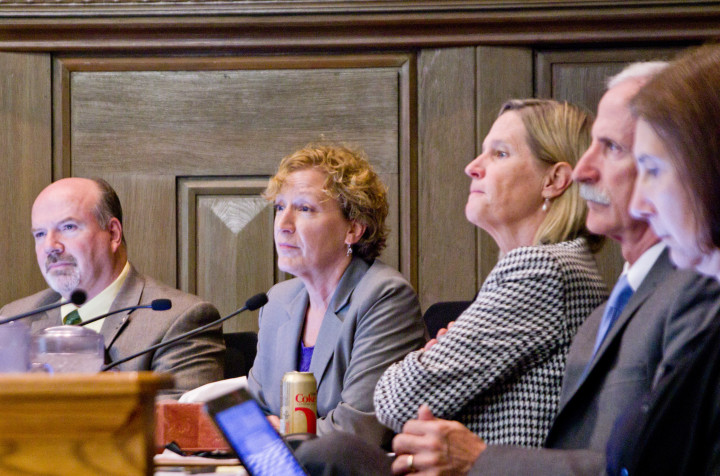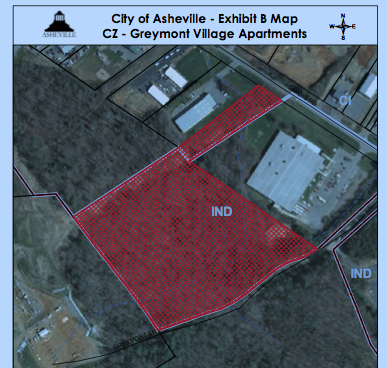Contention sprung from unexpected corners at the Asheville City Council meeting on Sept. 9, as Council members and a land developer stared each other down on rental rates and safety commitments for a proposed residential development on Sardis Road. Complicating the debate was the fact that about half the development falls within the city limits.
The applicant — Winston-Salem Industries for the Blind — seeks a rezoning of its property adjacent to the agency’s existing complex on Sardis Road. If adopted, the rezoning would change the property from industrial and commercial-use classifications to RM-16 — residential, multi-family high-density development (up to 16 units per acre).
The proposed rezoning would allow the agency to build Greymont Village, a 356-unit, 14-building apartment complex. At first, Vice Mayor Marc Hunt made a motion to approve the request. But Council members hesitated as they learned more about conditions that the city’s Planning and Zoning Commission had called for.
P&Z had recently approved the agency’s request, but on a split vote (4-3), city staff reported. The P&Z members who voted against it did so because the applicants would not commit to four conditions: keeping rents at “workforce” rates, setting aside 20 units for visually impaired residents, making an accessible path to the Industry for the Blind complex on the adjacent lot, and finally, installing a higher-standard sprinkler system than proposed.
Randy Buckner, Industries for the Blind director, assured Council members that the agency had addressed two of those issues — the pathway and setting aside units for visually impaired residents. But the agency and the developers wouldn’t budge on workforce rents and sprinkler systems.
“The unwillingness not to commit to those [rent levels] is a little tricky,” said Councilman Gordon Smith. “We’ve worked with a lot of builders up here who have been able to commit. … It’s a bit confusing to hear someone say ‘can’t.’ Doing some envelope math here, could you perhaps commit to doing an 82 percent of median? So it would move with the market?”
Workforce rent in Asheville is about $1,200 for a 1-bedroom, just over $1,400 for a 2-bedroom, and about $1,500 for a 3-bedroom, the agency noted in its presentation.
Lou Bissette, attorney for the applicant, insisted that the rents would remain lower than workforce levels — $877 for a 1-bedroom, for example — but that committing to a specific rate for a specific period of time would be difficult, if not impossible: “You’ve got to make these units work from an economic point of view,” he said. “I don’t think it’s something this owner is prepared to do. I wish it were possible, but it’s not.”
Bissette pointed out that one of the conditions for the building — the higher-standard sprinkler system — was prohibitive at “about $750,000 of additional cost.”
One of the project developers, Dennis Burton, agreed: “The way this project was put together, we can’t put on economic restrictions.”
But Council members Gwen Wisler and Chris Pelly voiced their concern.

“It seems like the developer is intent on doing the right thing,” said Wisler. “But without a commitment, I think it sets up a pretty unfortunate precedent when changes in zoning — it’s like ‘well, just trust me.’ I think it puts us in a difficult position in the future,” she explained.
Council member Cecil Bothwell pointed out that the $750,000 cost of installing an National Fire Protection Association 13R sprinkler system instead of the proposed one could be avoided simply by adding another access road, which, he said “surely would cost less than $750,000.”
Council member Jan Davis was the only Council member to support the proposal: “I had hoped we could find enough votes to make this happen. This is substantial housing, and it puts it in an area where there’s not a lot of affordable housing. … Things that have been said about this Council, and how hard it is to develop in Asheville, are partly coming true this evening.”
If denied, the developer could not submit another proposal unless it was “substantially different” than the original. With defeat of the proposal looming, Mayor Esther Manheimer asked the applicant to take a moment and “reconsider.”
After a short recess, Bissette told the Council that they would be open to discussing the rent issue.
Council passed a 7-0 motion to continue the discussion on the Oct. 14 meeting.
IN OTHER BUSINESS
Riverside development
Council unanimously approved the Riverside Drive Redevelopment Plan for several 10-acres sections of underutilized city-owned property in the River Arts District on Riverside Drive. City staff reported that $14.6 million in federal grants will offset the $30 million price tag of the various proposals in the plan, which calls for such “visitor amenities” as public restrooms, open space and “a place where one can always find some arts and culture programming happening.” The development plan also calls for several projects and incentives for refurbishing and re-using historical buildings, installing a wetlands area for storm water management, and commercial and residential development.
Form-based code for Haywood
Council also approved rezoning most of Haywood Road in West Asheville. From Patton Avenue to the French Broad, the corridor will be under form-based zoning codes which, according to city planner Alan Glines, “emphasize building form and character and their defining features and placement in relation to street and sidewalk to create a strong neighborhood context.”
There will be six different types of zoning, each with its own particular “feel.” The traditional district in the heart of the corridor, for example, will only allow a limited range and scale of development, and buildings that rise no higher than two stories, while the “expansion” district is mixed-use and designed for a wide range of commercial buildings, with a four-story limit.
Citizens voiced their concerns about new rezoning, such as how it relates to congestion on Haywood Road, building heights and spillover onto neighborhood streets, where patrons of Haywood street businesses already park when visiting the area.
“If you look at the plans, every two stories, there’s a ‘step-back’,” said Glines, responding to their concerns. “This reduces the scale. And not every property is actually going to be sized to fit a four-story building. Even if it’s in a district that allows four stories or taller, it still has to fit on the lot.”
In response to the traffic question, Glines said, “If we make this area pedestrian-friendly, we’re really supporting our transit. We also have to cooperate with the [state] Department of Transportation, and we’ll be partnering with them section by section.”
Affordable Housing appointments
Council also named reappointments and appointments to the Affordable Housing Advisory Committee: Reappointed Jayden Gurney and Mae Creadick; appointed Randall Barnett, James Mastrogiacomo and Laura Simmelink.
Action agenda: For a full list of Council actions, click here.
The next formal meeting of the Asheville City Council will be held on Tuesday, Sept. 23, beginning at 5 p.m.
PRIOR to the 5 p.m. formal meeting, City Council will be going on a tour of the 7th & 8th floors of City Hall beginning at 4:15 p.m. All will meet in the First Floor North Conference Room in City Hall and then proceed up as a group.




Jan Davis: “Things that have been said about this Council, and how hard it is to develop in Asheville, are partly coming true this evening.”
Thank you, Jan Davis, for pointing out what the partisan media will not. I would actually question the legality of a municipality denying property owner’s the exercise of their rights when they refuse city council’s extortionate demands to ameliorate a negative condition they themselves have brought about with their policy prescriptions.
So, just to clear things up, the developer in this instance is asking the City to rezone the property. Within a community that has zoning regulations, the property owner’s right to use the land is limited by the zoning designation that is applied to it. In this case, a different zoning designation is needed to construct multi-family housing. When a property owner requests that the City rezone his/her property, the Council has full authority to weigh the request against the needs, plans and goals of the greater community when making their discretionary decision. No one is being denied rights in this instance.
The property owner is being denied the right to use his own property as he sees fit. This leads to higher costs for housing, or, no housing. The property owner, in his frustration, can build somewhere else. That’s exactly what happened to Walmart on Smoky Park Highway. The city attempted to extort more and more from them so they took their development, 300+jobs and millions in city revenues and relocated just outside the city limits.
Extortion, violation of property right, theft. All immoral acts.